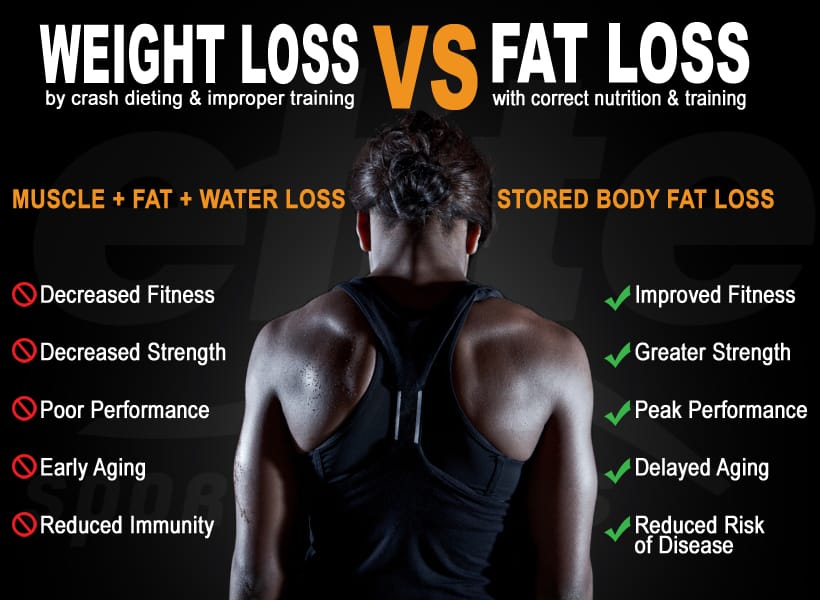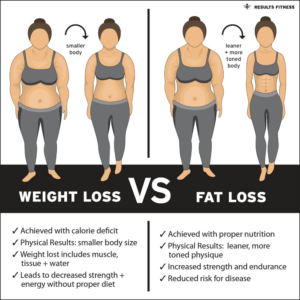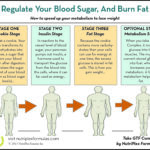Weight loss refers to a decrease in overall body weight. Body fat loss specifically targets the reduction of fat mass.
Understanding the difference between weight loss and body fat loss is crucial for achieving health goals. Weight loss includes the loss of muscle, water, and fat. Body fat loss focuses on reducing fat while preserving muscle mass. This distinction affects how one should approach diet and exercise.
Effective body fat loss requires a balanced diet and strength training. On the other hand, general weight loss might involve a broader calorie deficit. Knowing these differences helps in setting realistic expectations and achieving sustainable results. Aim for healthy habits that promote long-term well-being rather than quick fixes.

Credit: eliteclubs.com
Physical Differences
Understanding the physical differences between weight loss and body fat loss is vital. These terms are often used interchangeably, but they are not the same. Knowing the distinction can help you set better health goals.
Weight Vs. Fat
Weight refers to the total mass of your body. This includes bones, muscles, organs, water, and fat. When you step on a scale, it shows your weight.
In contrast, body fat is just one component of your weight. It’s the amount of fat stored in your body. Losing body fat leads to a leaner appearance, even if your weight does not change much.
Body Composition
Body composition measures the different components that make up your body. It includes fat, muscle, bone, and water.
Two people can weigh the same but have different body compositions. One may have more muscle, while the other has more fat. This difference affects their overall health and appearance.
Check out the table below to understand how weight and body fat differ in terms of body composition:
| Component | Weight Loss | Body Fat Loss |
|---|---|---|
| Total Body Weight | Decreases | May not change much |
| Body Fat Percentage | May or may not decrease | Decreases |
| Muscle Mass | May decrease | Generally preserved |
Understanding these differences can help you achieve a healthier and more sustainable lifestyle. Focus on reducing body fat rather than just losing weight.
Measurement Methods
Understanding the difference between weight loss and body fat loss is crucial. Knowing how to measure each can help you reach your goals. This section explores different measurement methods.
Scales And Bmi
Most people use scales to measure weight. A scale shows the total weight of your body. This includes muscle, fat, bones, and water. It’s a quick way to see changes in weight.
Another common method is Body Mass Index (BMI). BMI uses weight and height to classify weight status. The formula is:
BMI = weight (kg) / height (m)^2BMI categories:
- Underweight: BMI < 18.5
- Normal weight: BMI 18.5 – 24.9
- Overweight: BMI 25 – 29.9
- Obesity: BMI ≥ 30
BMI is easy to calculate. But, it does not measure body fat directly. It can be misleading for athletes or muscular individuals.
Body Fat Percentage
Body fat percentage is a better indicator of fat loss. It measures the proportion of fat in your body. There are various methods to measure body fat percentage:
- Skinfold Calipers: Measures skinfold thickness at different points.
- Bioelectrical Impedance: Uses a device to send an electrical signal.
- DEXA Scan: Uses X-rays to measure bone, fat, and muscle.
- Hydrostatic Weighing: Measures body density by submerging in water.
Each method has its pros and cons. Skinfold calipers and bioelectrical impedance are affordable and accessible. DEXA scans and hydrostatic weighing are more accurate but costlier.
Tracking body fat percentage helps you see real changes. It shows if you are losing fat or muscle. This helps in adjusting diet and exercise plans.
Health Implications
Understanding the health implications of weight loss versus body fat loss is essential. They impact your overall health differently. Knowing these differences helps you make informed decisions about your health journey.
Impact On Metabolism
Weight loss can sometimes slow down your metabolism. This is because the body may lose muscle mass along with fat. Muscle mass is crucial for a high metabolic rate. Losing muscle slows down calorie burning.
Body fat loss, on the other hand, focuses on losing fat while maintaining muscle mass. This approach keeps your metabolism steady. A steady metabolism helps in long-term weight management.
Risk Of Chronic Diseases
Excessive weight, especially fat, increases the risk of chronic diseases. These include type 2 diabetes, heart disease, and stroke. Focusing on body fat loss reduces these risks.
Weight loss through muscle loss does not provide the same benefits. You might still have a higher risk of chronic diseases. It’s important to aim for fat loss specifically.
| Factors | Weight Loss | Body Fat Loss |
|---|---|---|
| Metabolism | May slow down | Remains steady |
| Chronic Disease Risk | May remain high | Significantly reduced |
- Focus on losing fat, not just weight.
- Maintain muscle mass for a healthy metabolism.
- Reducing body fat lowers chronic disease risks.
Dietary Considerations
Understanding the dietary considerations is key to distinguishing between weight loss and body fat loss. Both require different approaches to diet and nutrition. These differences can significantly impact your results and overall health.
Calorie Deficit
Creating a calorie deficit is essential for both weight loss and body fat loss. This means consuming fewer calories than your body needs to maintain its current weight. You can achieve this through diet, exercise, or a combination of both.
| Weight Loss | Body Fat Loss |
|---|---|
| May lose muscle mass along with fat | Focuses on losing fat while preserving muscle |
| Requires a moderate calorie deficit | Requires a slightly smaller calorie deficit |
Macronutrient Balance
For effective body fat loss, paying attention to macronutrient balance is crucial. This involves the right proportion of proteins, fats, and carbohydrates in your diet.
- Proteins: Essential for muscle preservation and recovery.
- Fats: Important for hormone regulation and energy.
- Carbohydrates: Provide energy for workouts and daily activities.
Weight loss might only focus on reducing overall calorie intake, without balancing macronutrients. Body fat loss, on the other hand, emphasizes a balanced diet to retain muscle and lose fat efficiently.
Exercise Strategies
Understanding the right exercise strategies is key to achieving your fitness goals. Whether aiming for weight loss or body fat loss, your approach to exercise matters. This section will explore two crucial components: Cardio vs. Strength Training and Targeting Fat Loss.
Cardio Vs. Strength Training
Cardio exercises include running, cycling, and swimming. These activities increase your heart rate and help burn calories quickly. Cardio is excellent for weight loss because it burns more calories in less time.
Strength training involves lifting weights or using resistance bands. This type of exercise builds muscle mass. More muscle boosts your metabolism, helping you burn calories even at rest. Strength training is ideal for body fat loss because it targets fat while preserving muscle.
| Type of Exercise | Benefits | Ideal For |
|---|---|---|
| Cardio | Burns calories quickly | Weight Loss |
| Strength Training | Builds muscle, boosts metabolism | Body Fat Loss |
Targeting Fat Loss
To target fat loss, combine cardio and strength training. This combination ensures you burn calories and build muscle. Follow these steps for effective fat loss:
- Include 30 minutes of cardio, 3-4 times a week.
- Perform strength training exercises 2-3 times a week.
- Focus on compound movements like squats and deadlifts.
- Maintain a balanced diet rich in protein and fiber.
Remember, consistency is the key. Regular exercise and a healthy diet will help you achieve your goals. Aim for a balanced approach to see the best results.

Credit: resultsfitnessforlife.com
Psychological Factors
Understanding the psychological factors is crucial in distinguishing between weight loss and body fat loss. The way you think and feel about your body can influence your journey. Let’s delve into these aspects.
Body Image
Your body image plays a vital role in your fitness goals. People often confuse weight loss with a better body image. This isn’t always the case. You may lose weight but still feel unhappy with your appearance.
Focusing on body fat loss can lead to a more toned physique. This can improve your self-esteem and body satisfaction. A positive body image drives a healthier lifestyle.
Motivation And Sustainability
Motivation is key to achieving your fitness goals. Many start with high energy but lose steam quickly. Understanding the difference between weight loss and body fat loss helps in setting realistic goals.
Maintaining a healthy lifestyle requires sustainability. Crash diets may lead to quick weight loss but are hard to maintain. A focus on body fat loss promotes long-term health benefits. This is more sustainable and motivating.
Here’s a quick comparison to highlight the differences:
| Aspect | Weight Loss | Body Fat Loss |
|---|---|---|
| Goal | Reduce overall weight | Reduce fat percentage |
| Focus | Scale numbers | Body composition |
| Results | Temporary | Long-lasting |
Understanding these differences can improve your motivation and lead to better sustainability in your fitness journey.
Misconceptions
Understanding the difference between weight loss and body fat loss is crucial. Many people often confuse the two. This confusion leads to several misconceptions. Let’s discuss some common myths and their impact on your fitness goals.
Spot Reduction Myth
One common myth is the spot reduction myth. Many believe targeting fat loss in specific body areas is possible. For example, doing endless crunches to lose belly fat. This is not true. Fat loss happens throughout the body. It depends on genetics and overall activity levels. No exercise can target fat loss in one area.
- Crunches do not specifically burn belly fat.
- Leg lifts do not exclusively burn thigh fat.
- Fat loss requires overall body workouts and a healthy diet.
Scale Obsession
Many people have a strong scale obsession. They believe the scale number is the best measure of success. This is misleading. The scale does not show the full picture. Muscle weighs more than fat but takes up less space.
Consider these points:
- Muscle gain can lead to weight gain.
- Focus on body composition, not just weight.
- Inches lost can be a better measure than pounds lost.
| Weight Loss | Body Fat Loss |
|---|---|
| Can include water, muscle, and fat loss | Specifically targets fat loss |
| Often measured by the scale | Measured by body composition changes |
| May not improve body shape | Improves body shape and muscle definition |

Credit: www.facebook.com
Frequently Asked Questions
What Is Weight Loss?
Weight loss refers to a reduction in overall body weight, including muscle, water, and fat.
What Is Body Fat Loss?
Body fat loss specifically targets the reduction of fat mass while preserving muscle and water weight.
How Do They Differ?
Weight loss affects total body weight. Body fat loss specifically focuses on reducing fat, not muscle or water.
Which Is Healthier?
Body fat loss is generally healthier. It preserves muscle mass and focuses on reducing unhealthy fat.
Can Muscle Mass Affect Weight Loss?
Yes, muscle mass can affect weight loss. Gaining muscle might increase weight, even if you’re losing fat.
Is Diet Important For Fat Loss?
Yes, diet plays a crucial role. Consuming fewer calories and focusing on nutritious foods helps reduce body fat.
Does Exercise Help With Body Fat Loss?
Yes, exercise, especially strength training and cardio, helps burn fat and preserve muscle mass.
Conclusion
Understanding the difference between weight loss and body fat loss is crucial for effective fitness goals. Focus on reducing body fat for better health benefits. Choose sustainable methods like balanced nutrition and regular exercise. This approach will help you achieve long-term success and maintain a healthier lifestyle.




